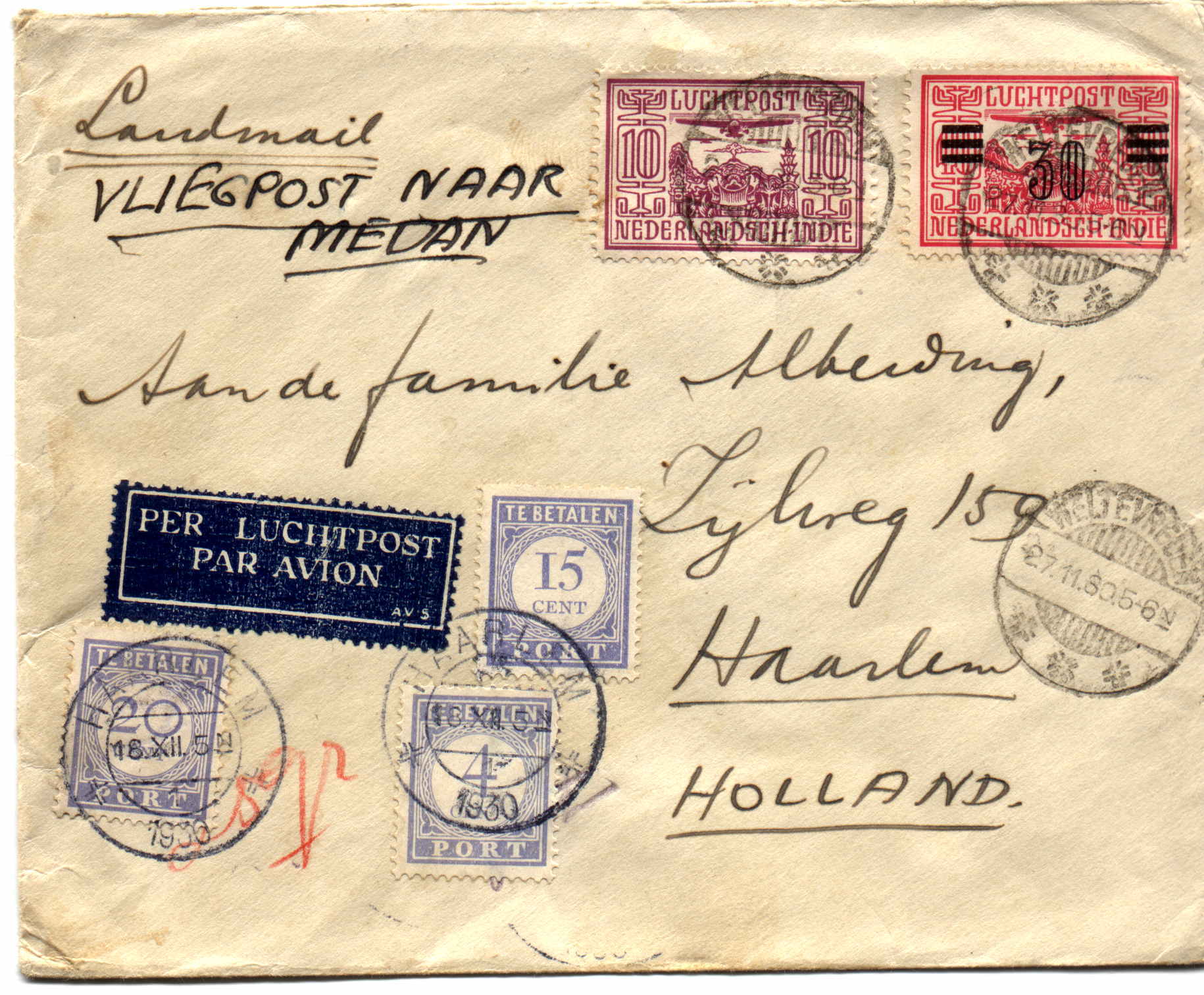How the PTT made 56 1/2 cent on a 22 1/2 cent letter

On November 27, 1930 a letter was sent from Weltevreden (Batavia/Jakarta) in the Dutch East Indies to Haarlem in the Netherlands, where the letter arrived on December 18, 1930.
The letter was franked with 2 D.E.I "luchtpost" stamps, one of 10 cent, the other one of 30 cent.
These special 'airmail stamps' were usually used when a letter was meant to be sent airmail.
During September 1930 the K.N.I.L.M had inaugurated a new airmail service between Batavia (Java) and Medan (Sumatra) which connected to the steamer mail to the Netherlands (Refer to John van Rysdam's article on this subject in the ASNP Journal of June, 1997). In order to make use of this service a notation "Vliegpost naar Medan" had to be written on the cover, as was done here.
The notation of "Landmail" indicated that the sender wanted the letter to be sent by steamer from Medan to Genua (Italy), and from there by train to Amsterdam and on to Haarlem, or to Marseille and from there to Rotterdam and on to Haarlem. It is not clear which exact route was taken, but by checking the schedules of the Rotterdamsche Loyd and the Nederlandse Stoomvaart Maatschappij for that period one should be able to solve this detail.
The franking for this eight gram letter should have been 12 1/2 cent for the landmail , plus 10 cent surcharge for the Weltevreden to Medan airmal part. Total of 22 1/2 cent.
The letter was franked with 40 cent, a 17 1/2 cent over franking.
When the letter arrived in Haarlem the postal clerk must have been confused by the "Per Luchtpost/Par Avion" sticker, as well as the two "luchtrecht " stamps. The clerk weighted the letter (it was 8 grams) and pulled out his book of postal rates.
The 'luchtrecht surcharge" for a letter between 5 and 20 grams was 75 cent. Adding this to the landmail rate of 12 1/2 cent he came to a total of 87 1/2 cent. Since there was 40 cents on the letter, there was a shortage of 47 1/2 (DEI) cent.
Then there were two other strange twists.
Postage dues from foreign countries were set at just the missing amount, not double as was the case for postage dues within the Netherlands.
The other twist was that the missing amount had to converted from the foreign currency to the Dutch equivalent in guilders. Tables existed with these conversion factors. However, the DEI guilder and the Dutch guilder had the same value, so the postage due would still be 47 1/2 cent. But no, the Dutch postal clerks reasoned that a letter sent from the Netherlands to a foreign country (this excluded the DEI since it was part of the Netherlands) would cost 12 1/2 cent, while a letter sent from the DEI to a foreign country (for the same reason this excluded the Netherlands) would cost 15 cent. So 12 1/2 cent Dutch money was set equal to 15 cent DEI money, a ratio of 5/6. Multiplying 47 1/2 cent by this 5/6 factor would mean that the postage due calculated should have been 40 cent. The clerk had a bit of trouble with rounding off and came up with 39 cent postage due. Of course this whole 5/6 ratio should b not have applied to a letter coming from the DEI.
So in the end the letter brought the Dutch PTT the 40 cent (DEI) and the 39 cent (Dutch) for a total of 79 cent, while 22 1/2 cent would have the correct rate; a profit of 56 1/2 cent.
A nice rate of return for the PTT!
References:
K.N.I.L.M Airmail Route from Java to Medan with the fast steamer connection to Europe and Holland,
John van Rysdam, ASNP Journal, Vol. 21/4, pages 78-86.
Van een halve cent tot één gulden vijf en zeventig. Een overzicht van de Nederlandse portzegels.
Drs. L. Goldhoorn, PO&PO, 1979
Luchtvaart en Luchtpost encyclopedie, deel 1, J.L.C.M. and H.H.C. TSchroots, PTT Post, 1990